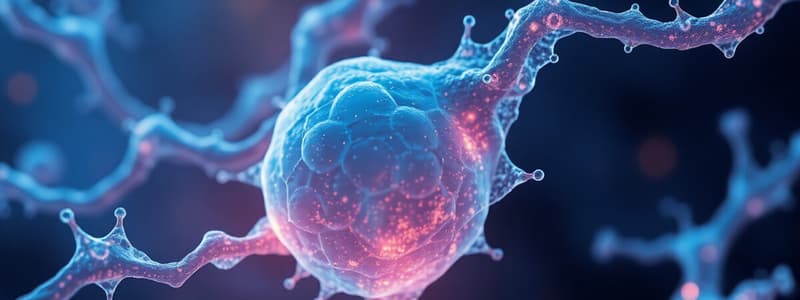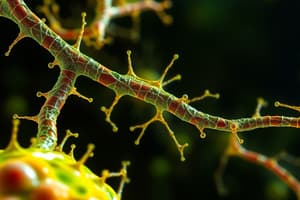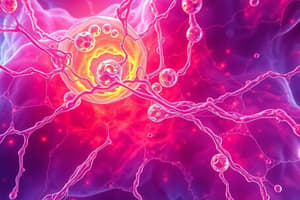Podcast
Questions and Answers
What is a primary function of the tunica intima in blood vessels?
What is a primary function of the tunica intima in blood vessels?
- To provide structural support to the vessel
- To allow for cell signaling between endothelial cells
- To regulate blood flow and pressure (correct)
- To facilitate nutrient exchange between the blood and surrounding tissues
Which component is not typically found in the tunica adventitia of blood vessels?
Which component is not typically found in the tunica adventitia of blood vessels?
- Elastic fibers
- Connective tissue
- Smooth muscle cells (correct)
- Collagen fibers
What role does the tunica media play in blood vessel function?
What role does the tunica media play in blood vessel function?
- Separating blood from surrounding tissues
- Providing a barrier to pathogens
- Maintaining the structural integrity of the vessel
- Facilitating vasodilation and vasoconstriction (correct)
Why is the extracellular matrix (ECM) significant in tissue organization?
Why is the extracellular matrix (ECM) significant in tissue organization?
How do cell-cell interactions influence cell differentiation?
How do cell-cell interactions influence cell differentiation?
What is the primary function of tight junctions in cell-cell interactions?
What is the primary function of tight junctions in cell-cell interactions?
Which component of the glycocalyx primarily consists of carbohydrate-containing structures?
Which component of the glycocalyx primarily consists of carbohydrate-containing structures?
Which junction connects actin filaments between cells?
Which junction connects actin filaments between cells?
What best describes the role of focal adhesions in cell adhesion?
What best describes the role of focal adhesions in cell adhesion?
What is a key feature of hemidesmosomes in terms of their function?
What is a key feature of hemidesmosomes in terms of their function?
The primary purpose of the glycocalyx in epithelial cells is to:
The primary purpose of the glycocalyx in epithelial cells is to:
Which junction type allows for the passage of small water-soluble molecules between cells?
Which junction type allows for the passage of small water-soluble molecules between cells?
Which extracellular component is primarily responsible for providing structural support to tissues?
Which extracellular component is primarily responsible for providing structural support to tissues?
What is the primary role of integrins in normal cells regarding their interaction with the ECM?
What is the primary role of integrins in normal cells regarding their interaction with the ECM?
Which of the following processes is influenced by outside-in signaling in cells?
Which of the following processes is influenced by outside-in signaling in cells?
Which type of junction is primarily responsible for sealing gaps between cells?
Which type of junction is primarily responsible for sealing gaps between cells?
What feature distinguishes cancer cells from normal cells regarding integrin signaling?
What feature distinguishes cancer cells from normal cells regarding integrin signaling?
What is a function of focal adhesions in cells?
What is a function of focal adhesions in cells?
Which of the following accurately describes the relationship between cytoskeletal rearrangements and ECM interactions?
Which of the following accurately describes the relationship between cytoskeletal rearrangements and ECM interactions?
In which type of junction are intermediate filaments connected between cells?
In which type of junction are intermediate filaments connected between cells?
What characteristic of hemidesmosomes is crucial for epithelial cells?
What characteristic of hemidesmosomes is crucial for epithelial cells?
Which of the following best describes inside-out signaling?
Which of the following best describes inside-out signaling?
Which statement best describes a role of the extracellular matrix (ECM)?
Which statement best describes a role of the extracellular matrix (ECM)?
What is a key characteristic of proteoglycans found in the extracellular matrix?
What is a key characteristic of proteoglycans found in the extracellular matrix?
What function do matrix metalloproteinases (MMPs) serve in the extracellular matrix?
What function do matrix metalloproteinases (MMPs) serve in the extracellular matrix?
How do integrins facilitate cell interactions within the extracellular matrix?
How do integrins facilitate cell interactions within the extracellular matrix?
Which aspect of proteoglycans contributes to the ECM's hydration and resistance to deformation?
Which aspect of proteoglycans contributes to the ECM's hydration and resistance to deformation?
What is the primary role of hemidesmosomes in epithelial cells?
What is the primary role of hemidesmosomes in epithelial cells?
Which of the following best describes the mechanism of focal adhesions?
Which of the following best describes the mechanism of focal adhesions?
Bullous pemphigoid is primarily associated with which type of tissue interaction?
Bullous pemphigoid is primarily associated with which type of tissue interaction?
What type of molecules are integrins primarily responsible for binding?
What type of molecules are integrins primarily responsible for binding?
What is a major characteristic of the extracellular matrix (ECM)?
What is a major characteristic of the extracellular matrix (ECM)?
Which of the following processes is NOT significantly influenced by focal adhesions?
Which of the following processes is NOT significantly influenced by focal adhesions?
What types of interactions do cell adhesion molecules primarily facilitate?
What types of interactions do cell adhesion molecules primarily facilitate?
In the context of hemidesmosomes, what role does laminin play?
In the context of hemidesmosomes, what role does laminin play?
Which condition is characterized by chronic autoimmune blistering due to hemidesmosomal protein attack?
Which condition is characterized by chronic autoimmune blistering due to hemidesmosomal protein attack?
What is the primary function of the tunica media in blood vessels?
What is the primary function of the tunica media in blood vessels?
Flashcards are hidden until you start studying
Study Notes
Cell-Cell/Cell-ECM Interactions
- Apical Surface
- Tight Junctions: Seal gap between cells.
- Adherens Junctions: Connect Actin filaments between cells.
- Desmosome: Connect Intermediate filaments between cells.
- Gap Junction: Allows passage of small water-soluble molecules.
- Hemidesmosome: Anchors intermediate filaments to the ECM in epithelial cells.
- Focal Adhesions: Anchor many cell types to the ECM.
Extracellular Components
- Glycocalyx: A cell coat of glycoproteins and glycolipids projecting outwards from the plasma membrane.
- Located at epithelial and endothelial cells.
- Mediates cell-cell and cell-substratum interactions.
- Provides mechanical protection (ECM) affecting ECM assembly, cell migration, and adhesion processes.
- Enables "outside-in signaling" where external environment signals affect differentiation, motility, growth, survival, cytoskeletal rearrangements, proliferation, gene expression, and cell polarity.
Cell-ECM Interactions
- Focal Adhesions: Anchor a cell to a substratum.
- Large clusters of integrins commonly seen in vitro but also found in muscle and tendons.
- Disassembled for cell movement or replication.
- Act as sensory structures sensing both chemical and physical properties of the extracellular environment.
- Hemidesmosomes: Specialized integrin adhesive structure in epithelial cells.
- More permanent anchor to the basement membrane.
- Laminin of the ECM binds to integrins, which are bound to dense collections of keratin intermediate filaments on a plaque of plectin inside the cell.
- Hemidesmosomes - Disease: Bullous pemphigoid is a rare skin condition causing large blisters.
- Auto-antibodies attack a hemidesmosomal protein called bullous pemphigoid antigen 1.
- Focal Adhesions vs Hemidesmosomes:
- Focal adhesions are temporary anchors that connect the cell to the ECM, allowing for cell migration and movement.
- Hemidesmosomes provide a strong, permanent anchor that connects epithelial cells to the basement membrane, providing structural support and stability.
Interaction of cells with extracellular materials
- Integrins: Membrane-spanning polypeptide chains (α and β) that bind to ECM components such as fibronectin, laminin, proteoglycans, and collagen.
- Non-covalently linked with >100 different pairings possible.
- Integrate extracellular and intracellular environments.
- Can bind Arg-Gly-Asp (RGD) sequences.
- Inside-out Signaling: Internal cell signals activate the integrins, influencing ECM binding and adhesion.
Extracellular Matrix
- Proteoglycans: ECM protein-polysaccharide complexes containing a core protein with glycosaminoglycans (GAGs) covalently attached.
- GAGs are highly acidic due to sulfate and carboxyl groups, giving them a negative charge.
- Bind cations and H2O, forming a porous, hydrated gel.
- Provide strength and resistance to deformation in cartilage and other ECM.
- Proteoglycan Complexes: Proteoglycans bind together, forming larger complexes linked by hyaluronic acid (a nonsulfated GAG).
Extracellular Matrix: Remodeling
- Dynamic: ECM components are continuously degraded and reconstructed.
- Renewal and Remodelling: Important for embryonic development, wound healing, and cancer metastasis.
- Matrix metalloproteinases (MMPs): Zinc-containing enzymes that degrade the ECM.
- Secreted into the ECM or anchored to plasma membranes.
- Digest nearly all ECM components.
- Involved in tissue remodeling, cell migration/invasion, wound healing, and neovasculogenesis.
Primordial Germ Cells
- Cell surface protein adheres strongly to a subunit of laminin, facilitating the migration of primordial germ cells along a tract of laminin.
Extracellular Matrix: Proteoglycans & Primordial Germ Cell Migration
- Proteoglycans play a pivotal role in the migration of primordial germ cells.
- They influence a cell's potential for migration, growth, and differentiation.
Studying That Suits You
Use AI to generate personalized quizzes and flashcards to suit your learning preferences.




